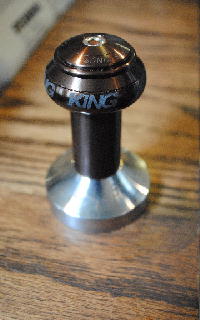
A common inquiry in the coffee shop is differentiating between ‘coffee’ and ‘espresso’. Is espresso just coffee? Why does it taste different? How is it stronger? Because knowledge is power, we want you to be a powerful coffee drinker, and knowing is half the battle.
The main difference between a cup of coffee and a shot of espresso is the brew method. Espresso can be made from any type of coffee bean, any roast, any region, blend or single origin, and is qualified by its transformation in an Espresso Machine.
The beans are ground more finely than when used in slower brew methods, to assist with the high rate of pressure at which water is pushed through. The grounds are packed tightly with a tamper into a portafilter, that doohickie that looks like a little cup with a handle on it, and secured in the machine. The temperature of the water should be between 192 and 204 degrees Fahrenheit and pushes through the grounds at a pressure rate of approximately 9BAR or atmospheres or 135 pounds per square inch, which is really intense. The shot length depends on the coffee bean and the consistency desired, but typically runs between 25 and 30 seconds.
The water temperature and pressure are crucial in making espresso. Smaller, home machines that use steam pressure are not able to reach these levels and do not result in the same beverage. So, when it comes to espresso, the machine is money.
What emits in this seemingly complex endeavor, is a 1 to 3 ounce yield of espresso, depending on how much coffee is used, with a complex, sweeter flavor. The crema on top, or the amber, almost creamy layer on top of the shot, is also unique to espresso. This layer adds a complexity to the flavor that makes espresso a win.
This Italian originating method is one we hold dear at Quills. The Americano and machiatto are drinks made with this fine method of coffee brewing. The down low on these drinks is soon to come. Go forth and use your knowledge for good.
 Saturday, April 2, 2011 at 12:47PM
Saturday, April 2, 2011 at 12:47PM  Quills is excited to announce we have procured a new grinder! It is the Tanzania model made by Mahlkoenig, a German company that is renowned for their high quality professional products. So fancy in fact they are the official grinder company for the World Barista Championship.
Quills is excited to announce we have procured a new grinder! It is the Tanzania model made by Mahlkoenig, a German company that is renowned for their high quality professional products. So fancy in fact they are the official grinder company for the World Barista Championship. Coffee Education,
Coffee Education,  Coffee World,
Coffee World,  Mahlkoenig,
Mahlkoenig,  Quills News
Quills News 







 930 Baxter Ave. Louisville, KY 40204
930 Baxter Ave. Louisville, KY 40204


